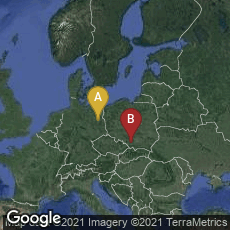

A: Bezirk Friedrichshain-Kreuzberg, Berlin, Berlin, Germany, B: małopolskie, Poland
Researchers at the United States Holocaust Memorial Museum in Washington, D. C. who in the year 2000 began documenting all the ghettos, slave labor sites, concentration camps and killing factories in operation during the Nazi regime, documented 42,500 Nazi ghettos and camps throughout Europe, located in German-controlled areas from France to Russia and in Germany from 1933 to 1945.
In 2009 the Holocaust Memorial Museum began publication of The United States Holocaust Memorial Museum Encyclopedia of Camps and Ghettos, 1933-1945. The vast encyclopedia would be complete in 7 volumes by 2025. In September 2020 the first three volumes were in print. They could also be downloaded free of charge from the museum website.
"Published by Indiana University Press in association with the Museum, each of the encyclopedia's seven volumes will address a group of sites according to type or subordination so that each volume can stand on its own. In this way, the reader can gain some appreciation for the conditions at a particular site as well as for how the system functioned as a whole. Photographs, charts, and maps will supplement the text.
"OVERVIEW
"VOL. I:
"EARLY CAMPS, YOUTH CAMPS, AND CONCENTRATION CAMPS AND SUBCAMPS UNDER THE SS-BUSINESS ADMINISTRATION MAIN OFFICE (WVHA). Editor: Geoffrey P. Megargee; Foreword: Elie Wiesel. Published June 2009.
"Contains entries on 110 early camps, 23 main SS concentration camps (including Auschwitz, Buchenwald, and Dachau), 898 subcamps, 39 SS construction brigade camps, and three so-called youth protection camps. Introductory essays provide broader context, while citations and source narratives offer the basis for additional research. The volume is more than 1,700 pages, with 192 photographs and 23 maps.
"VOL. II:
"GHETTOS IN GERMAN-OCCUPIED EASTERN EUROPE. General Editor: Geoffrey P. Megargee; Volume Editor: Martin Dean; Introduction: Christopher R. Browning. Published April 2012.
Provides a comprehensive account of how the Nazis conducted the Holocaust throughout the scattered towns and villages of Poland and the Soviet Union. It covers more than 1,150 sites, including both open and closed ghettos. Regional essays outline the patterns of ghettoization in 19 German administrative regions. Each entry discusses key events in the history of the ghetto; living and working conditions; activities of the Jewish Councils; Jewish responses to persecution; demographic changes; and details of the ghetto's liquidation. Personal testimonies help convey the character of each ghetto, while source citations provide a guide to additional information. Documentation of hundreds of smaller sites—previously unknown or overlooked in the historiography of the Holocaust—make this an indispensable reference work on the destroyed Jewish communities of Eastern Europe.
"VOL. III:
"CAMPS AND GHETTOS RUN BY EUROPEAN STATES AFFILIATED WITH NAZI GERMANY, including camps and ghettos in Croatia, Hungary, Italy, Romania, Bulgaria, Slovakia, and Vichy France. Editor: Joseph White.
"VOL. IV:
CAMPS AND OTHER DETENTION FACILITIES UNDER THE GERMAN MILITARY, including prisoner-of-war camps and military brothels. Co-editor: Rüdiger Overmans; Advisor: Pavel Polian.
"VOL. V:
"CAMPS UNDER THE SS-REICH SECURITY MAIN OFFICE AND THE HIGHER SS AND POLICE LEADERS, including the Operation Reinhard extermination camps, Gestapo prisons, and some categories of forced labor, detention, and transit camps.
"VOL. VI:
"NON-SS FORCED LABOR CAMPS, including forced labor camps under Organisation Todt, REIMAHG, local labor offices, and private firms.
"VOL. VII:
"OTHER KILLING AND DETENTION FACILITIES, including so-called euthanasia centers, Justice Ministry penal camps, “Germanization” camps for Polish children, and civilian prisons."
" 'The numbers are so much higher than what we originally thought,” Hartmut Berghoff, director of the institute, said in an interview after learning of the new data.
“ 'We knew before how horrible life in the camps and ghettos was,” he said, “but the numbers are unbelievable.”
"The documented camps include not only “killing centers” but also thousands of forced labor camps, where prisoners manufactured war supplies; prisoner-of-war camps; sites euphemistically named “care” centers, where pregnant women were forced to have abortions or their babies were killed after birth; and brothels, where women were coerced into having sex with German military personnel.
"Auschwitz and a handful of other concentration camps have come to symbolize the Nazi killing machine in the public consciousness. Likewise, the Nazi system for imprisoning Jewish families in hometown ghettos has become associated with a single site — the Warsaw Ghetto, famous for the 1943 uprising. But these sites, infamous though they are, represent only a minuscule fraction of the entire German network, the new research makes painfully clear.
"The maps the researchers have created to identify the camps and ghettos turn wide sections of wartime Europe into black clusters of death, torture and slavery — centered in Germany and Poland, but reaching in all directions."
"The numbers astound: 30,000 slave labor camps; 1,150 Jewish ghettos; 980 concentration camps; 1,000 prisoner-of-war camps; 500 brothels filled with sex slaves; and thousands of other camps used for euthanizing the elderly and infirm, performing forced abortions, 'Germanizing' prisoners or transporting victims to killing centers.
"In Berlin alone, researchers have documented some 3,000 camps and so-called Jew houses, while Hamburg held 1,300 sites.
"Dr. Dean, a co-researcher, said the findings left no doubt in his mind that many German citizens, despite the frequent claims of ignorance after the war, must have known about the widespread existence of the Nazi camps at the time.
“ 'You literally could not go anywhere in Germany without running into forced labor camps, P.O.W. camps, concentration camps,' he said. 'They were everywhere.'" (http://www.nytimes.com/2013/03/03/sunday-review/the-holocaust-just-got-more-shocking.html?hp, accessed 03-02-2013).